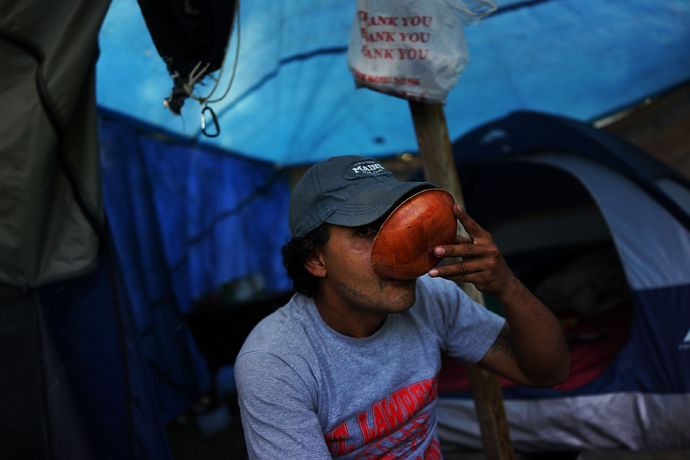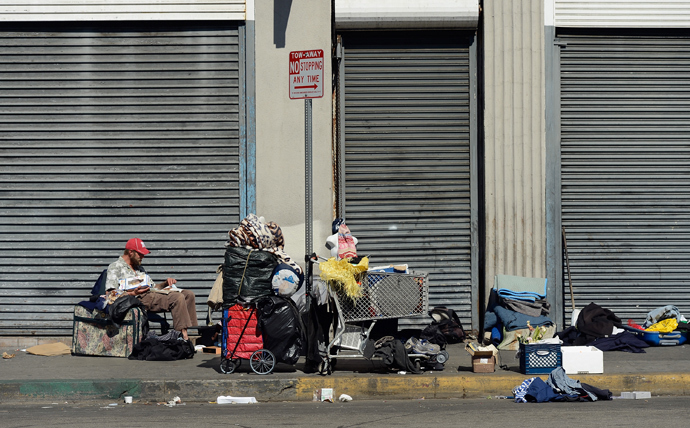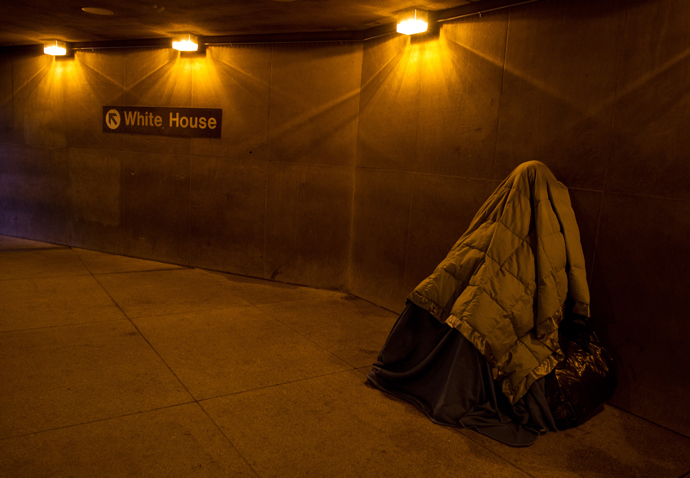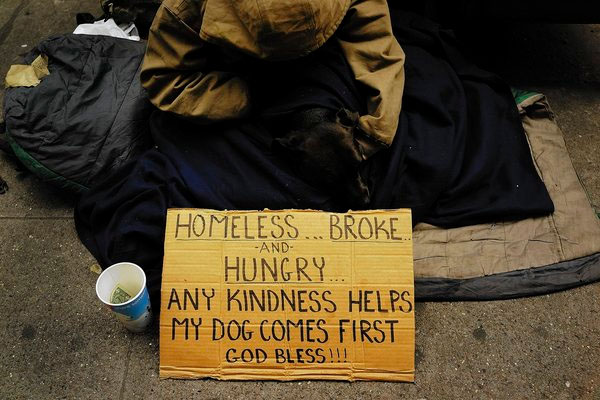
HOMELESSNESS, HUNGER CLIMBING IN U.S. CITIES, MAYORS' SURVEY SAYS
LATIMES
Although the jobless rate is at its lowest level in five years and the stock market has surpassed its pre-recession high, the economic gains have not reached many poor urban residents, and 2014 could be even worse, a new survey said Wednesday.
Homelessness and hunger have increased and are expected to keep rising in many cities next year, according to the latest U.S. Conference of Mayors survey of 25 large and midsized metro areas.
Last year’s national poverty rate of 15% is still near the Great Recession’s high of 15.1%, according to U.S. Census figures.
“We anticipated that problems related to unemployment and the slow national recovery would be reflected in the survey cities, and they were,” Santa Barbara Mayor Helene Schneider, a co-chair for the group’s task force on hunger and homelessness, told reporters in a conference call.
Officials involved in the urban survey said they were worried about recent cuts to food stamps and by the new congressional budget deal, which does not renew jobless benefits for the long-term unemployed. Those extended benefits will expire after Christmas.
“Despite the budget problems we all face, every level of government has got to [focus its resources] on solving these problems,” Schneider said.
The 25 surveyed cities, which include Los Angeles, Santa Barbara, Dallas, Chicago, Philadelphia and Washington, reported a 3% increase in overall homelessness, and half of the cities expected the number of homeless families to rise in 2014.
On an average night, more than 20,000 people sleep on Los Angeles’ streets, and almost 2,000 of them are families or children living on their own, the city reported. Homelessness has increased 26% in Los Angeles since last year, and 16% of L.A.’s homeless were turned away for housing help.
Chicago reported an 11.4% increase in the number of homeless families since last year, with requests for emergency food assistance up 6%. City pantries had to reduce the amount of food they gave to the hungry. And homeless shelters were increasing the number of people allowed to sleep in a room to meet rising demand.
Officials around the country cited a lack of affordable housing as a factor in persistent homelessness. Nineteen percent of the cities’ homeless adults had jobs, including 22% of those in San Francisco, according to the survey.
“The housing market is such, particularly over the last few years, that shelter is taking a large chunk of what money they have,” said Paul Ong, director of the Center for the Study of Inequality at UCLA’s Luskin School of Public Affairs. He added that median earnings for Americans had increased just 5% between 2007 and 2012, but that rents had risen 12%.
The result is a squeeze, he said. “You can’t pay for shelter and you end up being homeless. Or if you continue to live in the apartment, you have less available to you in terms of food, so you end up relying on other sources of food for your family.”
One bright spot in the survey: A wide majority of the cities said they had made gains in getting veterans off the streets and into housing.
National veteran homelessness rates plunged by 24% between 2010 and 2013, according to the U.S. Department of Housing and Urban Development.
“We’ve seen success across the country,” said Laura Green Zeilinger, deputy director of the U.S. Interagency Council on Homelessness, citing a federal plan to end veteran homelessness by 2015. “Now we must invest in solutions in staying that course.”
Some of the 2013 hunger stats were grim: Twenty-one percent of people needing emergency food assistance didn’t get it, and all but four of the 25 surveyed cities reported an increased need. The exceptions were Santa Barbara; Nashville; Plano, Texas; and St. Paul, Minn.
Overall, demand for food assistance rose 7%, and all but one of the cities — Dallas — expected demand to increase in 2014.
“The hungry and homeless issue continues to be with us,” said Tom Cochran, chief executive and executive director of the U.S. Conference of Mayors. “We are very concerned that before budget cuts take place, the mind-set of Washington does not understand what is happening in our neighborhoods and cities large and small across America.”
The cities surveyed were Asheville, N.C.; Boston; Charleston, S.C.; Charlotte, N.C.; Chicago; Cleveland; Dallas; Denver; Des Moines; Los Angeles; Louisville, Ky.; Memphis; Nashville; Norfolk, Va.; Philadelphia; Phoenix; Plano; Providence, R.I.; St. Paul; Salt Lake City; San Antonio; San Francisco; Santa Barbara; Trenton, N.J.; and Washington.
RT
Homelessness and hunger are spreading across America, according to a survey which looked at 25 big cities, including LA, San Francisco, Chicago, Boston and Washington; 21 percent of the demand for food assistance hasn’t been met during the past year.
Last year’s national poverty rate of 15 percent hovered near the Great Recession’s staggering record of 15 percent, according to the Census Bureau. Although the US stock market has surpassed its pre-recession high, poor residents of some major American cities have not gained from the country’s economic wins, the new report has shown. The number of people in the poverty trap went up from 46.2 million in 2011 to 46.5 million in 2012. These figures remained slightly changed from 2010 when the number of poor people reached the highest level in the more than half-century that poverty estimates have been published. The poverty rate in 2012 was 2.5 percentage points higher than that reported in 2007, the year before the economic recession.
Over 80 percent of US cities reported that requests for emergency food assistance had increased by an average of 7 percent over the past year. The rate of increase ranged from 15 percent in Salt Lake City, 12 percent in Washington DC, 11 percent in Dallas, and 10 percent in Charlotte and Trenton, to 5 percent in Cleveland and 4 percent in Louisville.
 Rafael Santiago, who is homeless and works as a day laborer, takes a drink outside of the tent encampment where he lives in Waterbury, Connecticut. (Spencer Platt / Getty Images / AFP)
Rafael Santiago, who is homeless and works as a day laborer, takes a drink outside of the tent encampment where he lives in Waterbury, Connecticut. (Spencer Platt / Getty Images / AFP)
Unemployment tops the list of causes of hunger cited by the survey cities, followed by low wages, poverty, and high housing costs.
The latest study conducted by the US Conference of Mayors has shown that among those requesting emergency food assistance nearly 60 percent were people in families; 43 percent were employed, 21 percent were elderly, and 9 percent were homeless. Emergency shelters in 71 percent of the survey cities had to turn away homeless families with children because no beds were available, while in two-thirds of the cities shelters had to turn away single people.
Over 90 percent of the surveyed cities reported an increase in the number of people requesting food assistance for the first time. However, it turned out that more than 20 percent of the people desperately needing emergency food assistance did not receive it.
In all of the responding cities, emergency kitchens had to reduce the quantity of food poverty-stricken people could receive at each visit or the amount of food offered per meal. In 78 percent of these cities, officials also had to cut down the number of times a person or family could visit a food kitchen each month. In two-thirds of the cities, facilities had to send people away due to a lack of resources, according to the report.
 A homeless man sits covered in snow early in Washington, DC. (AFP Photo / Karen Bleier)
A homeless man sits covered in snow early in Washington, DC. (AFP Photo / Karen Bleier)
Providing more jobs topped the city officials’ list of actions needed to reduce hunger, with 73 percent of the cities citing the measure as a key solution to the problem. Cited next on the list were increasing Supplemental Nutrition Assistance Program (SNAP) benefits (by 59 percent of the cities), providing more affordable housing (by 55 percent), and providing more employment training programs (by 45 percent).
Meanwhile, the House of Representatives has passed legislation that would cut the Supplemental Nutrition Assistance Program (SNAP) by at least $39 billion over ten years. The Congressional Budget Office estimates the bill would deny SNAP benefits to about 3.8 million low-income people in 2014, and to an average of nearly three million people each year over the coming decade.
When asked about the impact of the cuts in SNAP benefits currently being considered by Congress, the city officials warned that cuts would first and foremost reduce the availability of food to vulnerable people, including children and the elderly.
“In Massachusetts, 13 percent of our population relies on SNAP to have enough to eat and many supplement these benefits with food from the Greater Boston Food Bank and its member agencies. With cuts of $39 billion at the federal level, the 889,000 people who rely on hunger relief agencies will need even more support. This means the demand for nutritious food will increase. We will have to work harder to increase our food acquisition and distribution,”the Boston survey contributors noted.
 Homeless people rest on a public sidewalk in downtown skid row area of Los Angeles, California. (Kevork Djansezian / Getty Images / AFP)
Homeless people rest on a public sidewalk in downtown skid row area of Los Angeles, California. (Kevork Djansezian / Getty Images / AFP)
Officials in Charlotte, the largest city in the state of North Carolina, have also concluded that a greater number of people will be “forced to get by on less food”, adding that food costs are up from 8 to 15 percent over the same time last year. “Already, 40 percent of the families in our area must choose between paying rent or buying food. Every cut in benefits pushes people in need closer to the brink of poverty. Not having access to enough nutritious food creates a tragic legacy for children.”
Cleveland officials also fear their food banks and programs would be “severely strained”, and more people would go hungry simply because there is no way for the charitable food system to make up for such large-scale cuts. “Feeding America calculates that these cuts would be comparable to the entire network of more than 200 food banks across the country – and the thousands of pantries and programs to which they supply food – shutting down completely for a year.”
Meanwhile, the surveyed cities are under no illusion that requests for emergency food assistance will keep growing, with 55 percent expecting the increase to be substantial, and 41 percent expecting it to be moderate.
The impact of proposed cuts in SNAP benefits and the inability of food assistance programs to meet the increased demand that would result from cuts was pointed out as the biggest challenge in addressing hunger in the coming year by most cities.
 A homeless person covered in blankets for warmth, sleeps at the entrance of a Metro station near the White House in Washington, DC. (AFP Photo / Karen Bleier)
A homeless person covered in blankets for warmth, sleeps at the entrance of a Metro station near the White House in Washington, DC. (AFP Photo / Karen Bleier)
It has been noted that homelessness goes hand in hand with hunger, with the total number of homeless individuals increasing to over 50 percent over the past year, according to the survey. There’s been a 40 percent increase in Los Angeles and a 24 percent increase in Dallas, just to name a few.
The survey cities reported that on average 30 percent of homeless adults were severely mentally ill, while 17 percent were physically disabled, 16 percent were victims of domestic violence, and 3 percent were HIV Positive. Nineteen percent of homeless adults were employed and 13 percent were veterans. While San Francisco says there has been a 30 percent reduction of homeless veterans from 2011 to 2013, officials in Nashville reported that their most-needed resource continues to be “adequate, safe, clean, affordable housing units for homeless veterans”, as well as meaningful employment with a living wage, plus “more mental health resources, including non-VA clinicians who can diagnose PTSD [Posttraumatic stress disorder].”
Meanwhile, the number of families experiencing homelessness has also increased across the survey cities by an average of 4 percent, with 64 percent of the cities reporting an increase and two cities saying the number stayed the same.
Asked to identify the three major causes of homelessness among families with children, 68 percent of the cities cited poverty, 60 percent blamed lack of affordable housing, and 56 percent referred to unemployment.
During the past year, 35 percent of the survey cities introduced policies aimed at preventing homelessness among households that have lost, or may lose, their homes to foreclosure.
However, officials in 62 percent of the cities expect resources to provide emergency shelter to decrease over the next year, with 14 percent expecting that decrease to be substantial and 48 percent expecting it to be moderate.
While 46 percent of the survey cities expect the number of homeless individuals to increase over the next year, providing more mainstream assisted housing is at the top of the officials’ list of actions needed.
m
- See more at: http://globalresearchreport.com/2013/12/13/homelessness-hunger-climbing-in-u-s-cities-mayors-survey-says/?utm_source=feedburner&utm_medium=email&utm_campaign=Feed%3A+globalresearchreport+(Global+Research+Report)#sthash.d70rGkLV.setNH8Rr.dpuf

